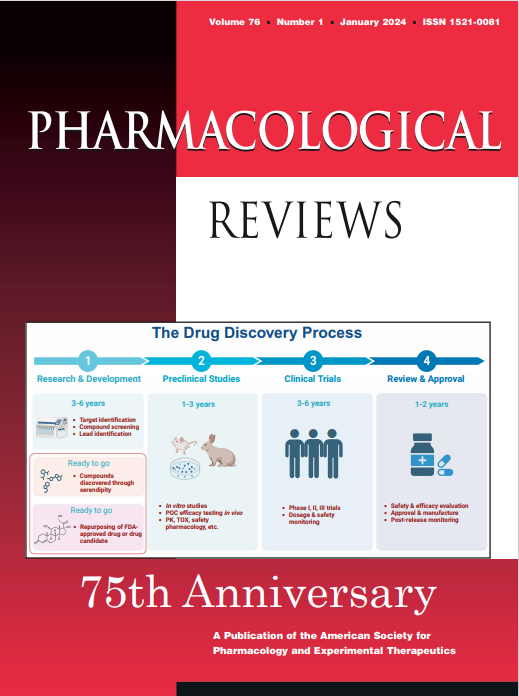Biochemistry, pharmacology and in vivo function of arginases.
IF 17.3
1区 医学
Q1 PHARMACOLOGY & PHARMACY
引用次数: 0
Abstract
Arginase catalyzes the hydrolysis of L-arginine into L-ornithine and urea. The two existing isoforms Arg1 and Arg2 show different cellular localizations and metabolic functions. Arginase activity is crucial for nitrogen detoxification in the urea cycle, synthesis of polyamines, and control of l-arginine bioavailability and nitric oxide production. Despite significant progress in the understanding of the biochemistry and function of arginases, several open questions remain. Recent studies have revealed that the regulation and function of Arg1 and Arg2 are cell-type-specific, species-specific, and profoundly different in mice and humans. The main differences were found in the distribution and function of Arg1 and Arg2 in immune and erythroid cells. Contrary to what was previously thought, Arg1 activity appears to be only partially related to vascular NO signaling under homeostatic conditions in the vascular wall, but its expression is increased under disease conditions and may be targeted by treatment with arginase inhibitors. Arg2 appears to be mainly a catabolic enzyme involved in the synthesis of L-ornithine, polyamine, and proline but may play a putative role in blood pressure control, at least in mice. The immunosuppressive role of arginase-mediated arginine depletion is a promising target for cancer treatment. This review critically revises and discusses the biochemistry, pharmacology, and in vivo function of arginase, focusing on the insights gained from the analysis of cell-specific Arg1 and Arg2 knockout mice and human studies using arginase inhibitors or pegylated recombinant arginase. Significance Statement The review emphasizes the need for further research to deepen our understanding of the regulation of Arg1 and Arg 2 in different cell types under consideration of their localization, species-specificity, and multiple biochemical and physiological roles. This could lead to better pharmacological strategies to target arginase activity in liver, cardiovascular, hematological, immune/infection diseases and cancer.精氨酸酶的生物化学、药理学和体内功能。
精氨酸酶催化 L-精氨酸水解为 L-鸟氨酸和尿素。现有的两种同工酶 Arg1 和 Arg2 显示出不同的细胞定位和代谢功能。精氨酸酶的活性对于尿素循环中的氮解毒、多胺的合成以及控制 L-精氨酸的生物利用率和一氧化氮的产生至关重要。尽管在了解精氨酸酶的生物化学和功能方面取得了重大进展,但仍存在一些未决问题。最近的研究发现,Arg1 和 Arg2 的调控和功能具有细胞类型特异性和物种特异性,而且在小鼠和人类中存在很大差异。主要差异体现在 Arg1 和 Arg2 在免疫细胞和红细胞中的分布和功能上。与之前的想法相反,在血管壁的平衡状态下,Arg1 的活性似乎只与血管氮氧化物信号传导有部分关系,但在疾病状态下,其表达会增加,并可能成为精氨酸酶抑制剂治疗的目标。Arg2 似乎主要是一种参与合成 L-鸟氨酸、多胺和脯氨酸的分解代谢酶,但至少在小鼠体内可能在血压控制方面发挥着潜在作用。精氨酸酶介导的精氨酸耗竭的免疫抑制作用是一个很有希望的癌症治疗目标。这篇综述对精氨酸酶的生物化学、药理学和体内功能进行了批判性修订和讨论,重点是分析细胞特异性 Arg1 和 Arg2 基因敲除小鼠以及使用精氨酸酶抑制剂或聚乙二醇化重组精氨酸酶的人体研究中获得的见解。意义声明 这篇综述强调,考虑到 Arg1 和 Arg 2 的定位、物种特异性以及多种生化和生理作用,我们有必要开展进一步研究,以加深对 Arg1 和 Arg 2 在不同细胞类型中调控作用的理解。这将为针对肝脏、心血管、血液、免疫/感染疾病和癌症的精氨酸酶活性制定更好的药理策略。
本文章由计算机程序翻译,如有差异,请以英文原文为准。
求助全文
约1分钟内获得全文
求助全文
来源期刊

Pharmacological Reviews
医学-药学
CiteScore
34.70
自引率
0.50%
发文量
40
期刊介绍:
Pharmacological Reviews is a highly popular and well-received journal that has a long and rich history of success. It was first published in 1949 and is currently published bimonthly online by the American Society for Pharmacology and Experimental Therapeutics. The journal is indexed or abstracted by various databases, including Biological Abstracts, BIOSIS Previews Database, Biosciences Information Service, Current Contents/Life Sciences, EMBASE/Excerpta Medica, Index Medicus, Index to Scientific Reviews, Medical Documentation Service, Reference Update, Research Alerts, Science Citation Index, and SciSearch. Pharmacological Reviews offers comprehensive reviews of new pharmacological fields and is able to stay up-to-date with published content. Overall, it is highly regarded by scholars.
 求助内容:
求助内容: 应助结果提醒方式:
应助结果提醒方式:


